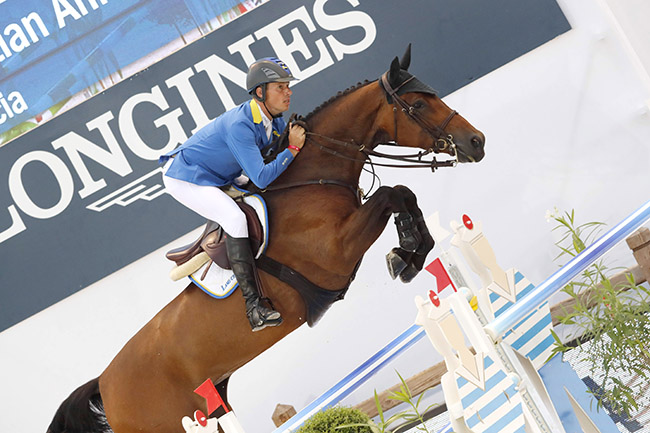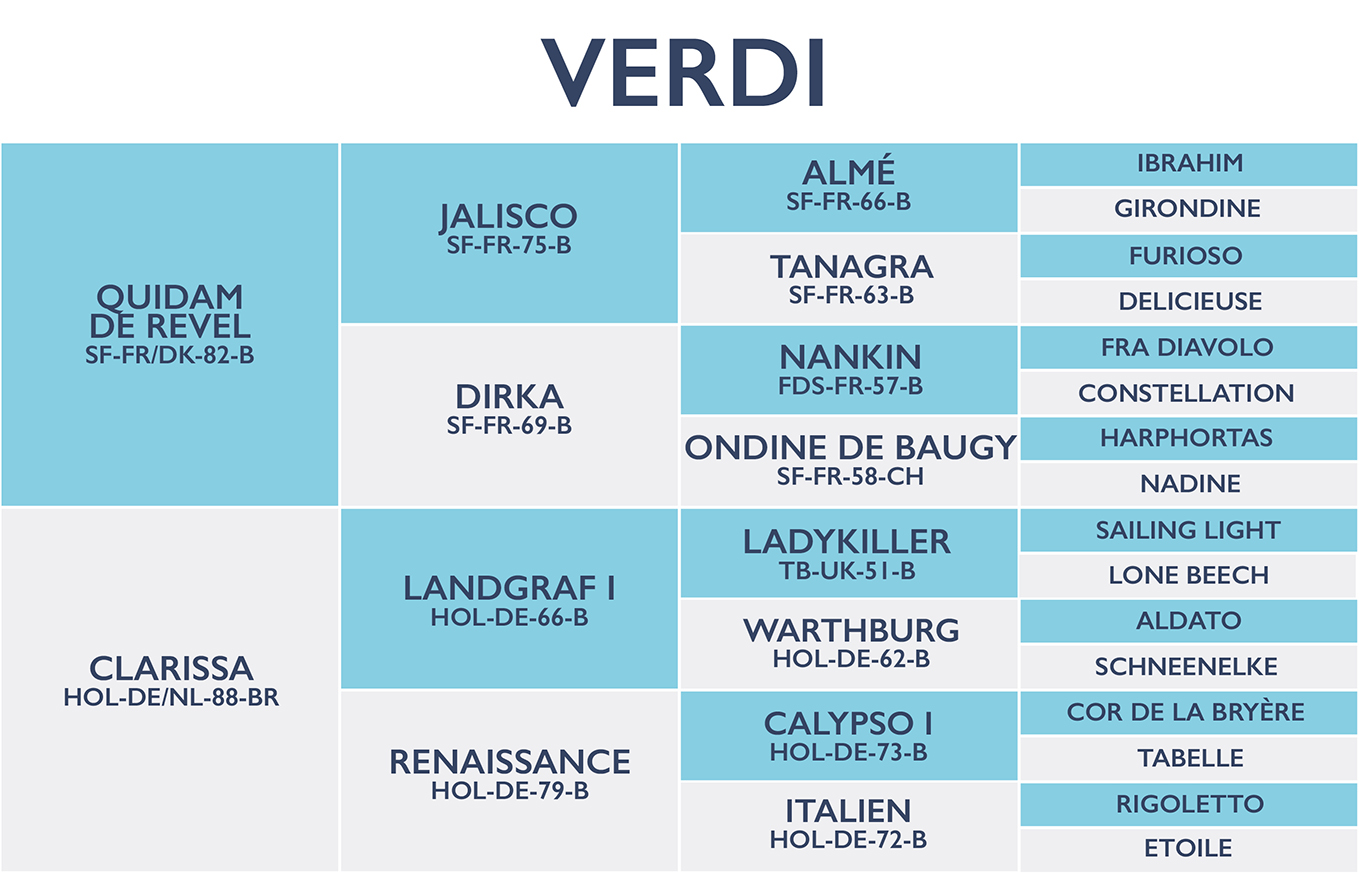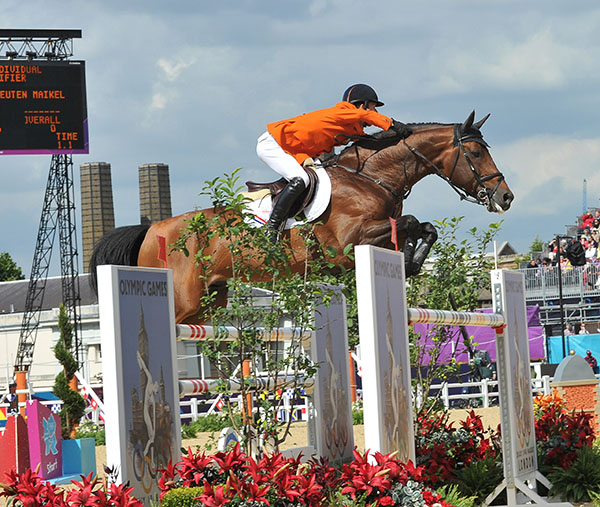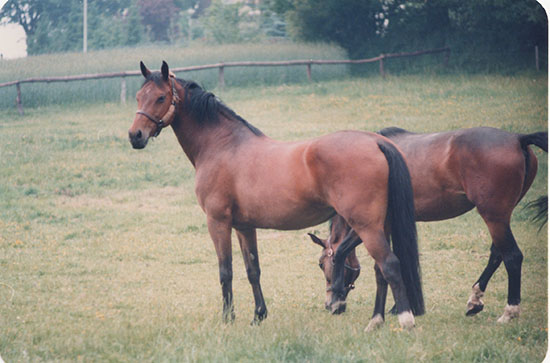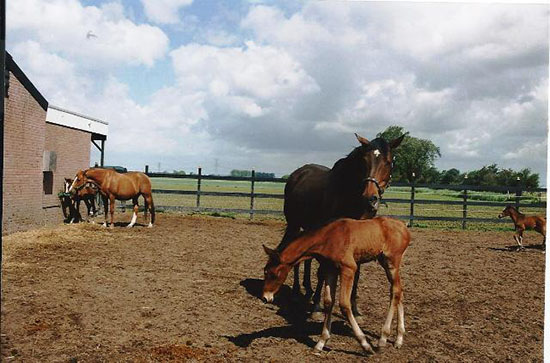2002 1.72 cm Bay
Breeder: Veehandel Musterd B. V.
Verdi and his rider Maikel van der Vleuten have a remarkable record on the international scene. As a seven-year-old, Verdi won the Dutch Young Horse Championship in 2009, and by 2011, he was a member of the Dutch Nations Cup Team and his stellar career was underway, a career that includes a team gold medal from the WEG in Caen, and a Silver from the London Games.
In 2014 alone, Verdi had wins in Paris, Barcelona and Madrid.
His oldest progeny are only babies, yet there are already 46 of his offspring who have competed internationally and who appear on the SJA data base.
There is not a lot that needs to be said about his sire, Quidam de Revel, but Verdi’s dam line is also exceptional, and not one, but two, of the members of the victorious Dutch team, Verdi AND Bubalu are from this famous Stamm 474a – known as the Plüschau stamm. This story has been excellently told by Adriana van Tilburg in her article Stamm 474a… Plüschau which will be appearing shortly on this website and I am indebted to her for all the following information.
The line begins in 1900 with the mare, Kiek, owned by Deidrich and Johannes Plüschau, and the stamm has been in the guardianship of the Plüschau family ever since.
The most important mare in this line, Pamina (by Fangball) was born in 1956. Pamina’s two daughters each established lines of their own. Zamora (by Aldato) leaves the legacy of Cavalier Royale (Cor de la Bryère), Cicero (Cor de la Bryère), Cicera’s Icewater (Corofino I), Krya III (Carthago), VDL Groep Spiga (Carthago) and Coolidge (by Clinton I).
But it is her full sister, Etoile who gave us Verdi and Bubalu.
Etoile…
According to Diedrich Plüschau and his ninety-year-old mother: “These mares were modern mares. Panima’s grandmother was a half blood mare, and her offspring were for the time (around 1950) modern horses. Pamina was the first mare that we didn’t use as a workhorse on the farm. She was very fertile, very honest and a kind mare. She died too early, poisoned from eating a toxic tree.”
But not before she bred Etoile by Aldato, who was by the Thoroughbred, Anblick. In fact, the 5th line of Etoile’s pedigree shows 10 Thoroughbreds out of sixteen ancestors.
Etoile was sold as a foal to Benno Hoff, who paid tribute to the Plüschau family’s vision: “For that time, she was a very modern type mare, and I want to give credit to the family Plüschau for breeding with Thoroughbreds and stallions that had Thoroughbred sires. Their horses were outstanding riding horses and they had a very modern type.”
“I rode her myself and she had very good gaits. Jumping wasn’t her thing. I brought her to Haselau because I thought they had the better stallions there at the time. I bred her to Rigoletto, a couple of times with Ladykiller xx, and with Farnese.”
Etoile produced twelve foals, five of them fillies who each started their own line. Her last foal was born in 1992, the approved stallion, Sir Tom (by Sir Shostakovich xx). Her daughter, Shoraya, by Ladykiller xx, was bred by Benno Hoff and sold to Maas J Hell who in turn sold her to Wiepke van der Lageweg (one of several occasions where the Dutchman just would not take no for an answer) and she became one of the foundation mares of the VDL stud, where she produced 16 foals. VDL has this to say about her: “Shoraya meant a lot to us, her offspring brought us many victories, as well in breeding as in sport. She built up one of the most successful mother-lines we have. She was a pretty and modern mare, she was well ahead of her time. She was champion at the approvals.”
Shoraya’s first foal, N-Aldato by the founding stallion of VDL, Nimmerdor, ridden by Emile Hendrix as Optiebeurs Aldato, won team gold at the European Champs in La Baule, and were members of a winning Nations Cup team at Aachen.
Her second foal, Zancara, also by Nimmerdor, produced four approved stallions, three of which jumped at Grand Prix level: Bubalu (Baloubet du Rouet), Montreal (Indoctro) and Pessoa (Animo).
Etoile’s daughter, Italien by Rigoletto is important to our story. Italien produced five daughters. Her first, Vanessa III (by Landgraf) is the dam of Calato (Capitol I), who jumped internationally and sired, Coster who took Christian Ahlmann to a European championship in 2003, and another stallion, Calandro (by Carthago).
It is the second daughter, Renasissance by Calypso I, who leads us to Verdi. Bred to Landgraf, she produced Clarissa who was a brood mare in The Netherlands at the stud, Veehandel Musterd B. V. According to Petra Musterd: “We bought Clarissa as a seven-year-old. We bred Clarissa for a few years, but we flushed four embryos and that damaged her uterus, we had to put her down. We sold Verdi as a foal to Nijhof and van de Oetelaar for 25,000 Dutch guilders. Back then this was a lot to pay for a foal. Verdi was the only colt we bred out of Clarissa, she only produced fillies. Verdi was a very sweet foal.”
Verdi as a foal…
Henk Nijhof Jnr told Jenneke Smit, the author of KWPN Stallion Verdi – Superior in Both Sport and Breeding, KWPN International, that his father knew the mare line:
“My father was interested in Verdi even before he was born and had pretty much committed to buying him. Soon after Verdi’s birth, Van den Oetelaar went to look at him and was immediately smitten. Since then we’ve shared the registration of the stallion. At the time, he was a very nice Quidam de Revel, and that hasn’t changed. We prepared him for the stallion selection and presented him to the KWPN. I’m not quick to praise a horse, but Verdi has always been special to me. He always jumped well at home, and fortunately he also jumped well at the stallion selection. In ‘s-Hertogenbosch he jumped really well so a lot of people were surprised when Verdi wasn’t invited for the championship. Perhaps it had something to do with his Register A papers.”
Verdi went well at his Performance Test as a three-year-old, but a jumping score of 7.5 did not put him in the top group for his year. Arie Hamoen, Chairman of the Stallion Selection Committee, explained to Jenneke: “We had no doubts about Verdi’s jumping talent, but he’s built a little on the forehand, which is reflected in his way of moving and jumping. For those reasons, the test riders were not unanimously for his approval, although the Committee had no doubts. However, that issue played a part in his score for jumping talent.”
Verdi attracted many mares right from the start and at the age of ten, is still very popular, but his popularity has spread. According to Henk Senior: “At first he was used only in The Netherlands, but over time, foreign breeders also started showing interest in him. I think that to date he has probably served more foreign mares that Dutch mares, Because of his outstanding achievements at Grand Prix-level, he’s in demand world-wide.”
Verdi has been a very good sire of mares, according to Arie Hamoen: “Verdi seems to leave his stamp more on mares than on stallions. The mares usually have more ‘blood’ and are noted for their good reflexes over jumps. The stallions are less consistent, and although we’ve selected several for the performance test, we haven’t been able to approve any yet.”
According to Jenneke, Henk Sr agrees the mares are initially more talented, but sees hope in the future for his colts: “His oldest offspring are getting better. Verdi was also a horse that needed time, even though he always performed well. His oldest male offspring jump better now than when they were three, so that gives us a lot of hope for the future.”
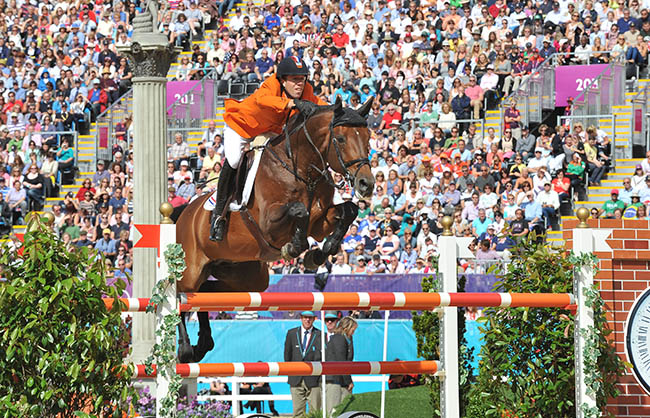
As a two year old, Verdi was approved by the KWPN, the Performance Test Report in 2005 notes:
“Conformation description
A richly developed, more than sufficient riding type stallion that is somewhat on the forehand. The neck comes from deep in the chest. The topline is strongly muscled. The stance of both the foreleg and the hindleg is correct, The base is sufficiently developed.
Performance
Verdi is an honest and dependable stallion. He has more than sufficient willingness to work and he works more than sufficiently. The walk is pure and scopey. The trot has sufficient, to more than, scope with sufficient suppleness. The canter has sufficient, to more than sufficient, scope. Verdi is on the forehand in all three gaits and should bring the hindleg underneath more actively and with more power. Verdi has little talent for dressage and gives his rider a moderate feeling.
Verdi jumps from the ground with much power with a nice high croup. The stallion bascules well. Verdi has good use of the body over the jump. The hindquarter opens well. He seems careful and shows a lot of scope. Verdi has more than sufficient to much talent for jumping and gives his rider a more than sufficient feeling.
Verdi appears to fit mares that lack scope and/or size and substance. Mares do have to have to be built uphill, show blood and be ‘rittig’.”
Which is more or less the advice that Nijhoff stud principal, Jeannette Benedict-Nijhof gives:
“Verdi gets even more popular because he is now starting his seventh year of Grand Prix. He has done Olympics, World Equestrian Games, World Cup finals, and the good thing is that he now has many offspring competing at international level. He makes very nice offspring, he imparts his qualities to his children. They are a little bit late growing like himself, they start to jump exceptionally well at five and six-years-old. In the mare test for three-year-olds, they don’t look so spectacular, but they are really nice when they are older. He goes well with mares that have blood. He looks quite a modern stallion, so you think you can use him on heavy mares, but they get too cold. You need a percentage of blood in the dam line and not too small, and a nice medium size, 165/170 cm, and a bit of blood, not a big bully mare.”
On the 2015/16 KWPN breeding values, Verdi is in 20th place on the ranking for stallions with a reliability of over 90%, with a value of 138 (95%). He has produced 1113 progeny over the age of 4, with 330 registered for competition, that’s 29.649%.
On the 2016/17 KWPN breeding values, Verdi has moved to 11th place on the over 90% rankings, with a value of 141. He scores 109 for conformation, 102 for loose movement and 109 for freejumping. His progeny over 4 now number 1204, with 368 competing – 30.56%.
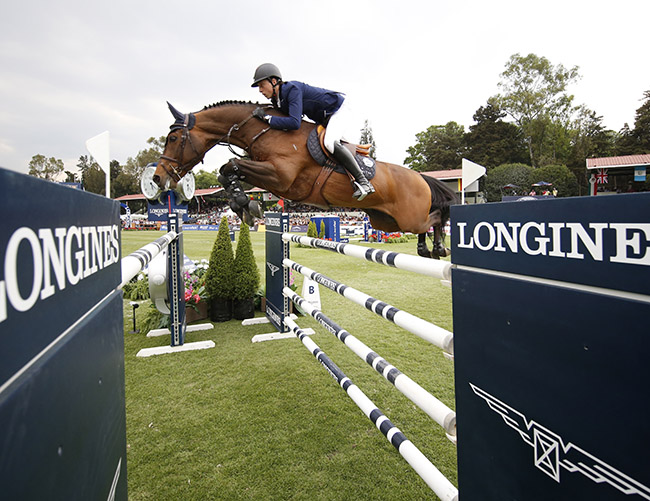
Chaplin by Verdi out of a Concorde mare, wins the 2017 Mexico City Longines Grand Prix – photo Stefano Grossi
And here is another – Monte Carlo GP winners, Christian Ahlmann and Dolocia – by Verdi out of a Furore mare.
